The Pact for the Future seems nice
An open, inclusive, clean and beautiful world of lasting peace, universal security and shared prosperity
The “Pact for the Future”, hailed by our space lizard overlords as “the most-wide ranging international agreement in many years”, was adopted by the United Nations General Assembly on September 22.
Probably you heard about it. But maybe you would like to hear more about it?
What does this fancy Pact say about the Future?
As per UN tradition, the Pact for the Future was written in incomprehensible space lizard hieroglyphs.
James Corbett was kind enough to provide an abridged English translation.
But if you want to marvel at how the UN decodes its own mystifying word salad, I encourage you to read this press release:
United Nations adopts ground-breaking Pact for the Future to transform global governance
New York, 22 September 2024 – World leaders today adopted a Pact for the Future that includes a Global Digital Compact and a Declaration on Future Generations. This Pact is the culmination of an inclusive, years-long process to adapt international cooperation to the realities of today and the challenges of tomorrow. The most wide-ranging international agreement in many years, covering entirely new areas as well as issues on which agreement has not been possible in decades, the Pact aims above all to ensure that international institutions can deliver in the face of a world that has changed dramatically since they were created. As the Secretary-General has said, “we cannot create a future fit for our grandchildren with a system built by our grandparents.”
Overall, the agreement of the Pact is a strong statement of countries’ commitment to the United Nations, the international system and international law. Leaders set out a clear vision of an international system that can deliver on its promises, is more representative of today’s world and draws on the energy and expertise of governments, civil society and other key partners.
“The Pact for the Future, the Global Digital Compact, and the Declaration on Future Generations open the door to new opportunities and untapped possibilities,” said the Secretary-General during his remarks at the opening of the Summit of the Future. The President of the General Assembly noted that the Pact would “lay the foundations for a sustainable, just, and peaceful global order – for all peoples and nations.”
The Pact covers a broad range of issues including peace and security, sustainable development, climate change, digital cooperation, human rights, gender, youth and future generations, and the transformation of global governance. Key deliverables in the Pact include:
In the area of peace and security
The most progressive and concrete commitment to Security Council reform since the 1960s, with plans to improve the effectiveness and representativeness of the Council, including by redressing the historical under-representation of Africa as a priority.
The first multilateral recommitment to nuclear disarmament in more than a decade, with a clear commitment to the goal of totally eliminating nuclear weapons.
Agreement to strengthen international frameworks that govern outer space, including a clear commitment to prevent an arms race in outer space and the need to ensure all countries can benefit from the safe and sustainable exploration of outer space.
Steps to avoid the weaponization and misuse of new technologies, such as lethal autonomous weapons, and affirmation that the laws of war should apply to many of these new technologies.
On sustainable development, climate and financing for development
The entire Pact is designed to turbo-charge implementation of the Sustainable Development Goals.
The most detailed agreement ever at the United Nations on the need for reform of the international financial architecture so that it better represents and serves developing countries, including:
Giving developing countries a greater say in how decisions are taken at international financial institutions;
Mobilizing more financing from multilateral development banks to help developing countries meet their development needs;
Reviewing the sovereign debt architecture to ensure that developing countries can borrow sustainably to invest in their future, with the IMF, UN, G20 and other key players working together;
Strengthening the global financial safety net to protect the poorest in the event of financial and economic shocks, through concrete actions by the IMF and Member States;
and accelerating measures to address the challenge of climate change, including through delivering more finance to help countries adapt to climate change and invest in renewable energy.
Improving how we measure human progress, going beyond GDP to capturing human and planetary wellbeing and sustainability.
A commitment to consider ways to introduce a global minimum level of taxation on high-net-worth individuals.
On climate change, confirmation of the need to keep global temperature rise to 1.5 °C above pre-industrial levels and to transition away from fossil fuels in energy systems to achieve net zero emissions by 2050.
On digital cooperation
The Global Digital Compact, annexed to the Pact, is the first comprehensive global framework for digital cooperation and AI governance.
At the heart of the Compact is a commitment to design, use and govern technology for the benefit of all. This includes commitments by world leaders to:
Connect all people, schools and hospitals to the Internet;
Anchor digital cooperation in human rights and international law;
Make the online space safe for all, especially children, through actions by governments, tech companies and social media;
Govern Artificial Intelligence, with a roadmap that includes an International Scientific Panel and a Global Policy Dialogue on AI;
Make data more open and accessible, with agreements on open-source data, models, and standards;
This is also the first global commitment to data governance, placing it on the UN agenda and requiring countries to take concrete actions by 2030.
Youth and future generations
The first ever Declaration on Future Generations, with concrete steps to take account of future generations in our decision-making, including a possible envoy for future generations.
A commitment to more meaningful opportunities for young people to participate in the decisions that shape their lives, especially at the global level.
Human rights and gender
A strengthening of our work on human rights, gender equality and the empowerment of women.
A clear call on the need to protect human rights defenders.
Strong signals on the importance of engagement of other stakeholders in global governance, including local and regional governments, civil society, private sector and others.
There are provisions across the Pact and its annexes for follow-up action, to ensure that the commitments made are implemented.
Summit Process
The Summit process and the Pact have been deeply enriched by the contributions of millions of voices and thousands of stakeholders from around the world.
The Summit brought together over 4000 individuals from Heads of State and Government, observers, IGOs, UN System, civil society and non-governmental organizations. In a broader push to increase the engagement of diverse actors, the formal Summit was preceded by the Action Days from 20-21 September, which attracted more than 7,000 individuals representing all segments of society. The Action Days featured strong commitments to action by all stakeholders, as well as pledges of USD 1.05 billion to advance digital inclusion.
[End of UN Gobbledygook]
You can read the adopted document here (.pdf). But why do that when you can search for Multipolar Keywords? Allow me to demonstrate:
But if you’re looking for a one-sentence summary of the Pact of the Future it would have to be: “Our friendly and selfless governments promise to turbocharge the implementation of the 2030 Agenda for Sustainable Development.”
How was this extremely sustainable accord adopted?
Without a vote.
The Pact was adopted via “consensus”. What is “consensus”? Good question. The UN explains:
When a decision is taken by consensus, no formal vote is taken. A 2005 Legal Opinion distinguishes consensus as follows: consensus “is understood as the absence of objection rather than a particular majority” (UN Juridical Yearbook 2005, page 457).
So basically you can force through a UN resolution without a vote and even without majority support, so long as no one points out that that’s an insane thing to do. Not the global governance we need, but probably the global governance we deserve.
However, all it takes is one party-pooper member state to spoil the multipolar no-vote “consensus” happy times:
Member States consider it very important to adopt a resolution that has the widest possible agreement among Member States. Before taking action on a draft resolution, Member States spend hours discussing every word in the resolution to reach agreement on the text.
When consensus on the text is reached, in the General Assembly all Member States agree to adopt the draft resolution without taking a vote. Adopting a draft without a vote is the most basic definition of what consensus means. If 192 Member States agree on the text, but just one Member State requests a vote, then consensus is not reached.
By the UN’s own admission, roughly 80% of the General Assembly resolutions are adopted by consensus.
Anyway.
The Pact for the Future was adopted without a vote using “consensus”, and now that you understand what that means, we can move on to the next topic: Moscow’s perplexing objection-but-not-actual-objection to the Pact of the Future.
Moscow “distances” itself from “consensus” that it agreed to (????????)
A day before the Pact was adopted, Russian Foreign Ministry spokesperson Maria Zakharova told the media that “work on the draft of the main part of the Pact is progressing very slowly”:
The co-coordinators of the negotiations are largely oriented towards Westerners and do not fully take into account the concerns of the countries of the World Majority. As a result, the current version of the document contains many ambiguous passages. We are talking about the erosion of the intergovernmental nature of the UN by equalizing the rights of member states and non-state actors, selectively listing the norms of international law, emphasizing the human rights component in the activities of the Organization, establishing a universal link between climate and security issues, advocating for accelerated progress on the track of nuclear disarmament, etc.
The Global Digital Compact was also causing friction. Zakharova accused Moscow’s Western partners of “trying to stake out a monopoly on Internet regulation, to put states and non-governmental structures on the same level in decision-making on the international technological agenda.”
In contrast, Zakharova said Russia and “like-minded” states “emphasize the urgency of specific measures to quickly overcome the ‘digital divide’ in order to achieve the Sustainable Development Goals.”
When voting consensus time arrived, Russia together with Belarus, North Korea, Iran, Nicaragua, and Syria, proposed an amendment to the Pact:
The Pact for the Future
After paragraph 17, insert the following paragraph:
We reaffirm that the United Nations shall be driven by intergovernmental decision-making process and that the United Nations and its system shall not intervene in matters which are essentially within the domestic jurisdiction of any State as provided in Article 2 (7) of the Charter of the United Nations and request the Secretary-General to evaluate the United Nations, its funds and programmes on compliance with this duty, as well as duplication of efforts, in particular as a result of the adoption of this Pact, and submit to the General Assembly at its eightieth session proposals on avoiding such duplication while achieving maximum resource efficiency.
However, the proposal was swiftly shut down by … Congo:
[T]he representative of the Republic of the Congo, speaking for the African Group, underscored the need to show unity in finding solutions to today’s multiple, complex challenges. The adoption of such an amendment “is not going to help us meet our expectations”, he stressed, proposing a motion that no action be taken on the draft amendment. That motion [to vote against Russia’s amendment] was adopted by a recorded vote of 143 in favour to 7 against (Belarus, Democratic People’s Republic of Korea, Iran, Nicaragua, Russian Federation, Sudan, Syria), with 15 abstentions.
Addressing the “Summit of the Future” on September 23, Russia’s Deputy Minister of Foreign Affairs Sergey Vershinin said that the “final versions of the Pact and its annexes retained non-consensus elements that do not contribute to the achievement of the stated goals of the Summit and are fraught with negative consequences for the very foundations of the UN’s work.” He continued:
Russia did not block the adoption of the Pact and joined the previously voiced statement of the Group of Friends in Defense of the UN Charter. At the same time, we distance ourselves from the consensus on the Pact and the Digital Compact, especially on the elements voiced below.
In concrete terms, we cannot support formulations aimed at undermining the intergovernmental nature of the Organization. Selective citation of generally recognized principles of international law is also unacceptable. Thus, the document does not directly mention the principle of non-interference in the internal affairs of sovereign states, nor the principle of cooperation.
We, like a number of states pursuing sovereign foreign policies, cannot support strengthening the role of the Office of the UN High Commissioner for Human Rights, which is known for its bias and pandering to Western interests.
We oppose forcing the process of nuclear disarmament. Against the background of ignoring the principle of equal and indivisible security, such ideas are frankly unrealistic, if not destructive.
The Global Digital Compact also contains serious flaws. It attempts to equate non-governmental actors with states in decision-making on the international technology agenda, as well as to create additional review mechanisms on this track with unclear mandates.
Of course, the documents adopted at the Summit contain some ideas that meet the expectations of the global majority. These include reform of the global financial architecture, expanding access to technology and overcoming the "digital divide" in the interests of achieving the Sustainable Development Goals. We would like to welcome the Declaration of Future Generations, which clearly demonstrates that consensus in the Organization is possible if there is political will for it.
Vershinin concluded by stating Moscow’s position that the “the final documents of the Summit do not impose obligations on provisions for which there is no consensus.”
To summarize: Moscow allowed the pact to be adopted without a vote via “consensus”, but then after the pact was approved said it would distance itself from certain aspects of this “consensus”—which is sort of confusing?
Obviously Washington got gay-married to the Pact. But where was BRICS to defend the Multipolar World Order from this Fake Unipolar Consensus?
Actually, China is quite fond of the Pact for the Future
On September 19, China’s Ministry of Foreign Affairs published a “Position Paper of the People’s Republic of China for The Summit of the Future and the 79th Session of The United Nations General Assembly”:
In the new era, faced with the major question of our times, i.e. what kind of world to build and how to build it, China has given its answer—building a community with a shared future for mankind. The goal of building a community with a shared future for mankind is to build an open, inclusive, clean and beautiful world of lasting peace, universal security and shared prosperity; the pathway is promoting global governance that features extensive consultation and joint contribution for shared benefit; the guiding principle is to apply the common values of humanity; the basic underpinning lies in building a new type of international relations…
[…]
China supports the U.N. Summit of the Future, and calls on the international community to take this opportunity to focus on the common well-being of humanity, build consensus and synergy, and support the central role of the U.N. in international affairs.
In a speech before the General Assembly on September 23, Chinese Foreign Minister Wang said that “countries are not riding separately in some 190 small boats, but rather we're all in a giant ship on which our shared destiny hinges”:
Chinese Foreign Minister Wang Yi reiterated, “Greater solidarity and cooperation of the international community is not a choice, but a must.”
Addressing the Summit of the Future Plenary today (23 Sep) in New York, Foreign Minister Wang proposed “a future of peace and tranquility.”
He said, “In this changing and turbulent world, new risks and challenges keep cropping up. No country can stay unaffected.”
The Chinese official reiterated that countries should “uphold the vision of comprehensive, cooperative and sustainable security, and settle disputes through dialog, resolve differences through consultation, and enhance security through cooperation.”
“Major countries in particular, should lead by example,” Foreign Minister Wang added, “They should break geopolitical circles by pursuing the greater good, rise above block confrontation and serve as propellers for world solidarity, anchors for international peace.”
The Chinese official also heighted that we should build a future of development and prosperity.
He said, “In today's world, countries are not riding separately in some 190 small boats, but rather we're all in a giant ship on which our shared destiny hinges. Small boats may not survive wind and waves, but a giant ship is strong enough to brave the stormy seas.”
“Countries need to share development opportunities and pursue win-win cooperation,” Wang said, adding that, “we need to follow a people centered development philosophy and advocate a universally beneficial and inclusive economic globalization to deliver the fruits of development.”
The Chinese official also stressed the need for “a future of fairness and justice.”
He said, “All countries, regardless of their size and strength, are equal members of the international community. International affairs should be handled through consultation by all countries.”
Wang continued, “We need to build an equal and orderly multipolar world and defend the UN centered international system, the international order based on international law and the basic norms of international relations underpinned by the purposes and principles of the UN Charter.”
“We need to strengthen the authority of international rule of law, reject the law of the jungle, where the strong bully the weak oppose acts of hegemonism such as unilateral sanctions,” Wang added.
The Foreign Minister also affirmed China’s supports on the UN in serving as the main channel in AI governance.
He concluded, “We will propose the AI capacity building action plan for good and for all. In particular, we need to encourage young people to bring out their creativity and contribute their share to the advancement of humankind.”
Meanwhile, Chinese state media published glowing reviews of the Summit and the resulting Pact:
There’s a lesson here, somewhere.
I suppose the space lizards will do what they must. They’re an incorrigible bunch.
But the Edward Institute for Village Studies has a slightly different vision of the Future. One that involves push-carts. And we will not be deterred.
Until next time.

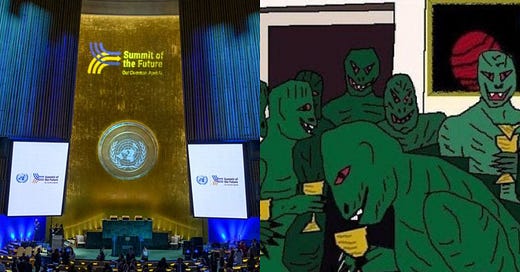



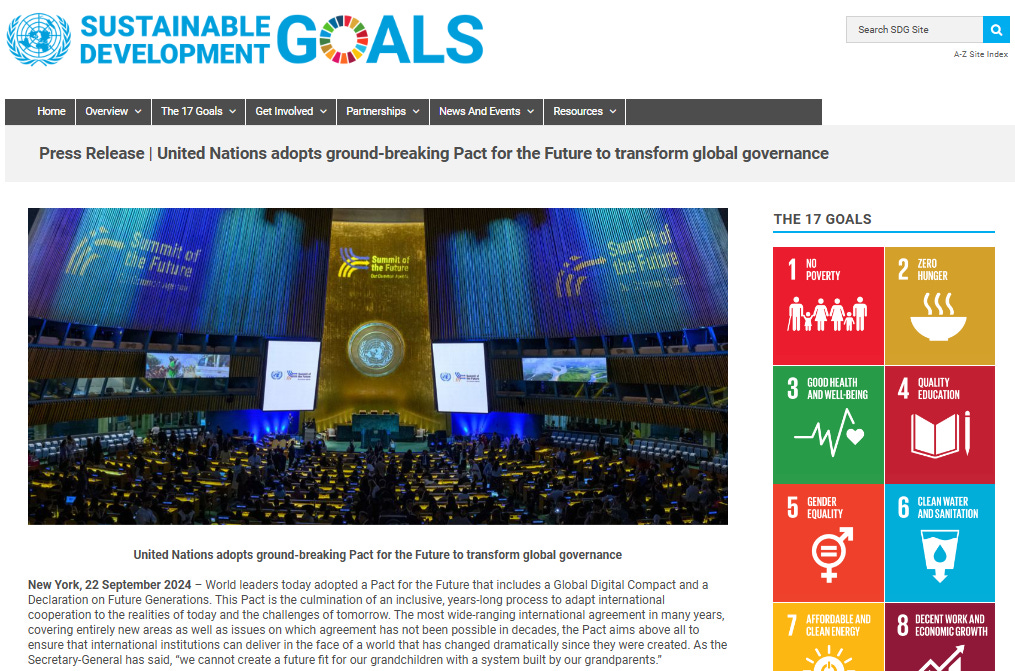
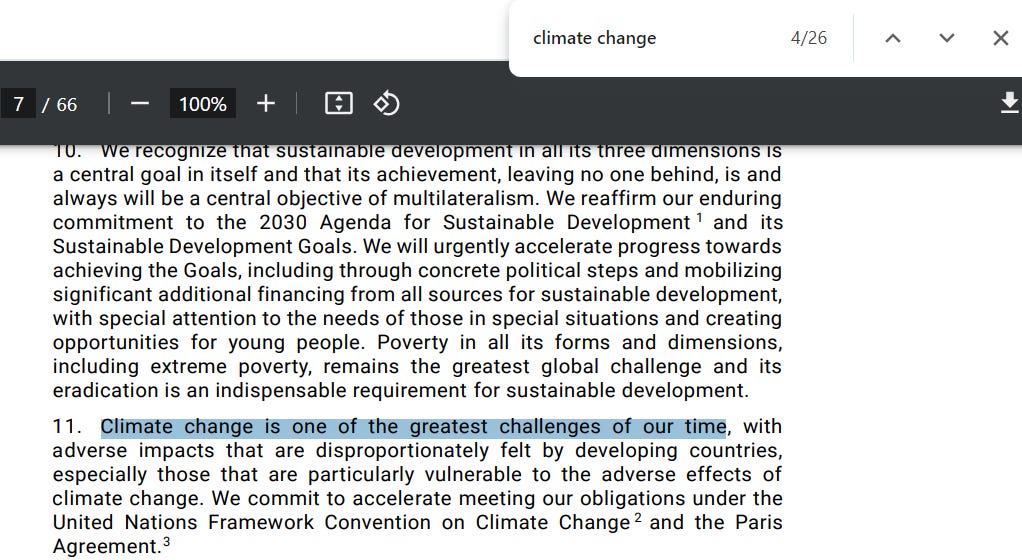
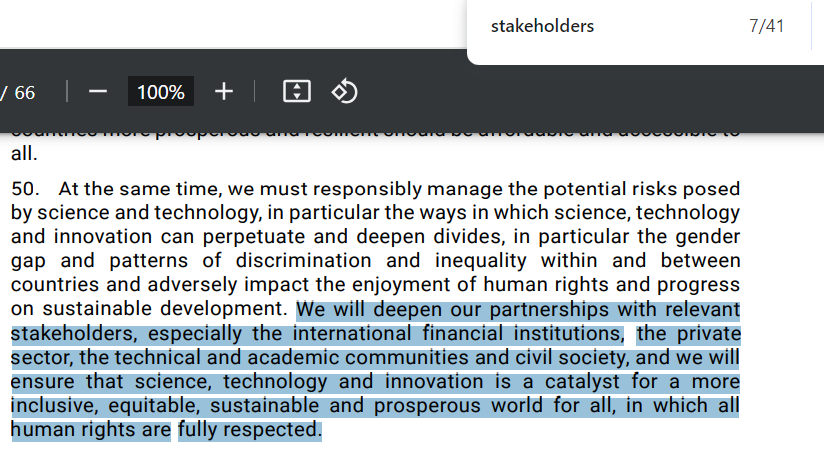
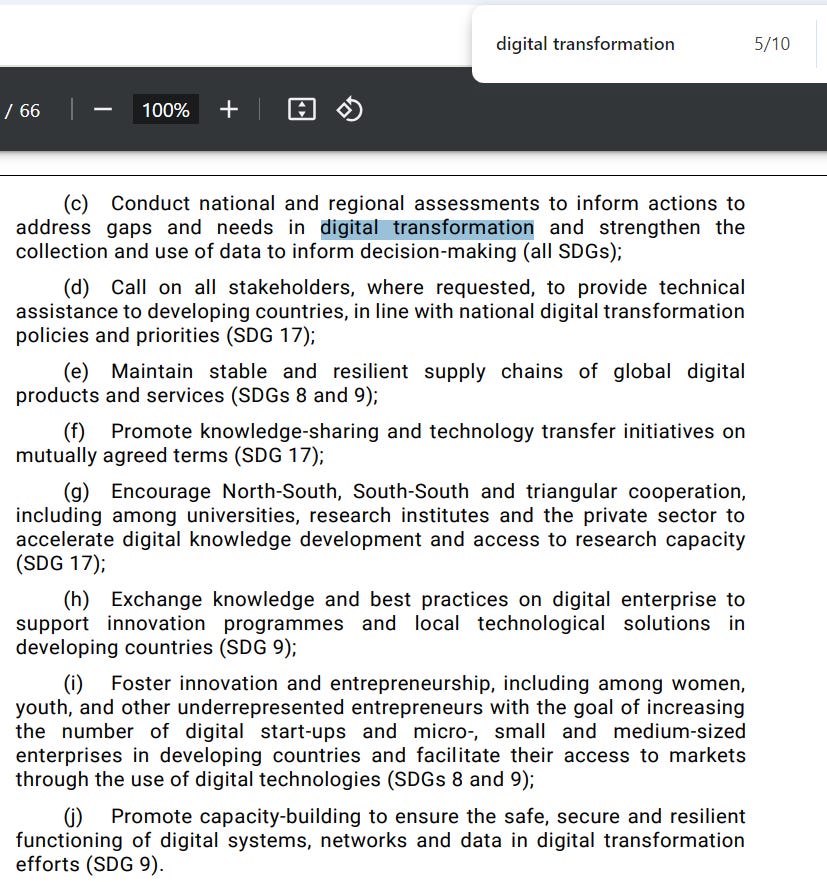
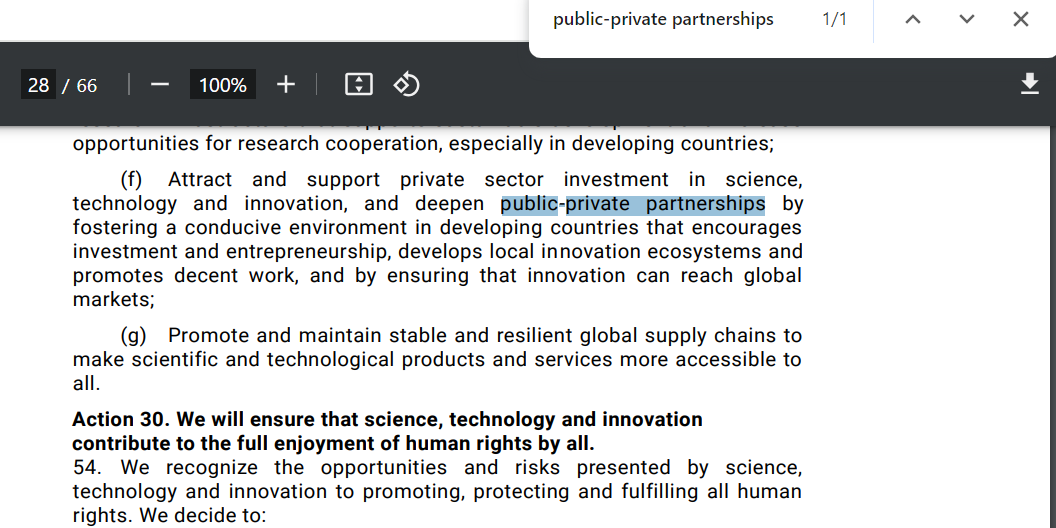
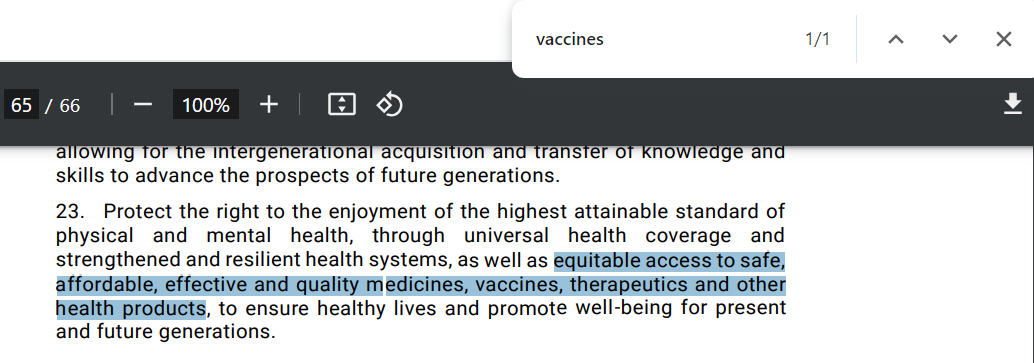
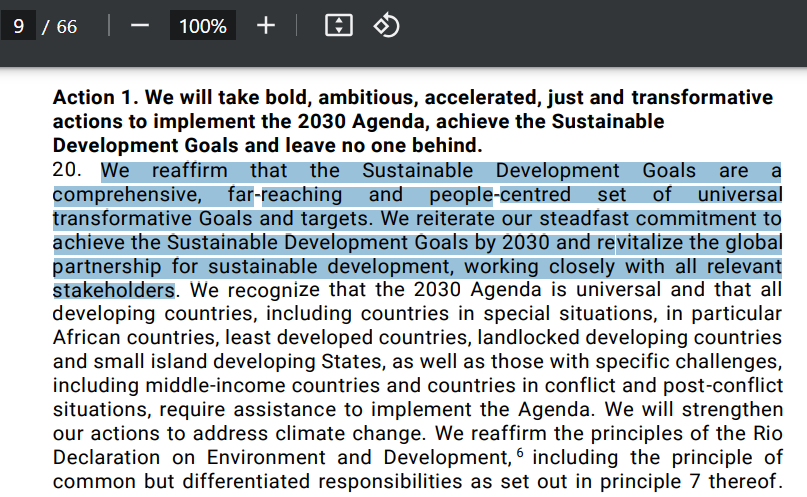
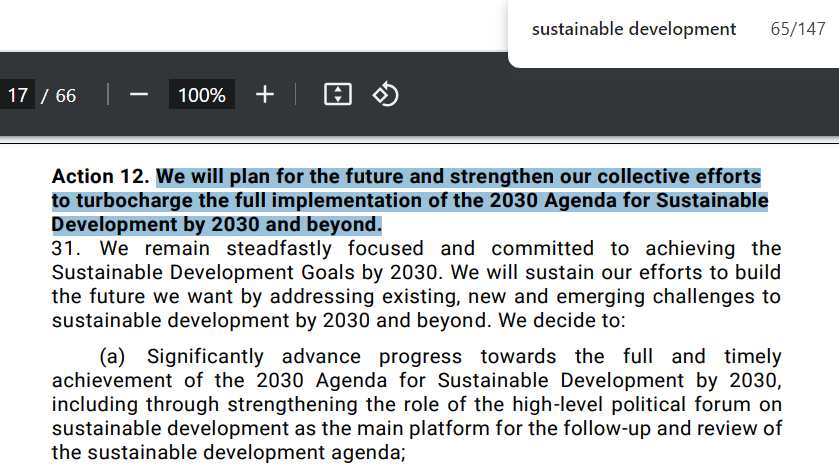
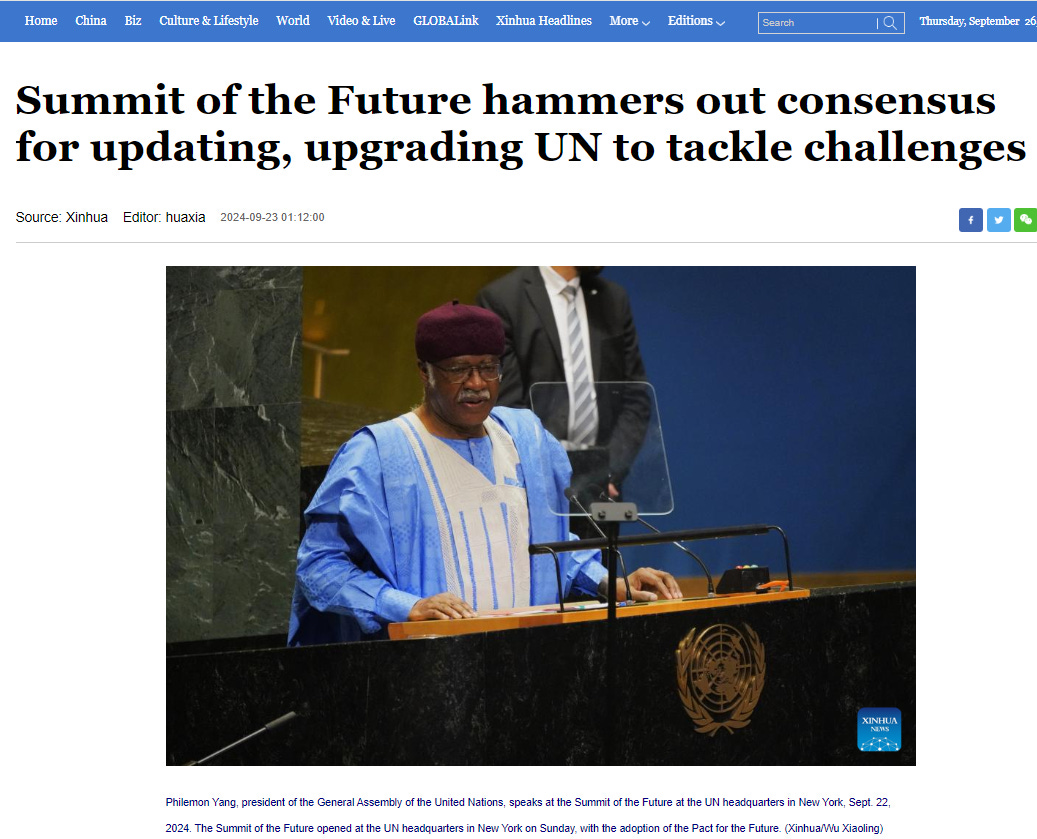
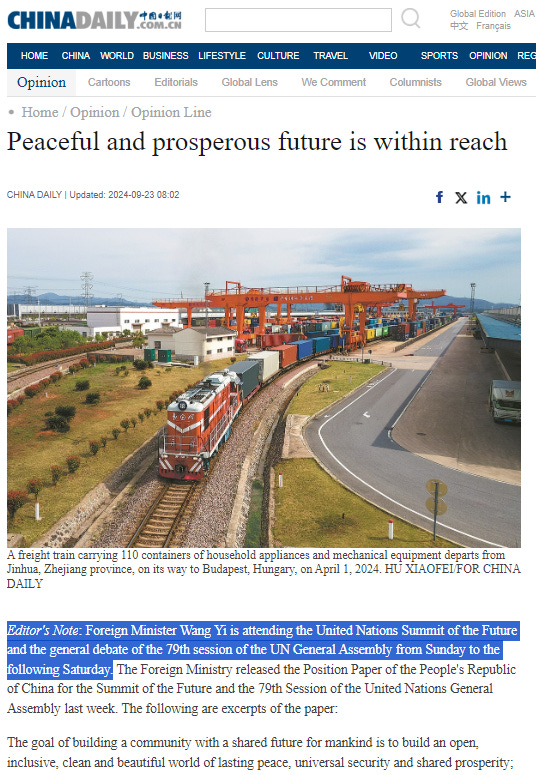
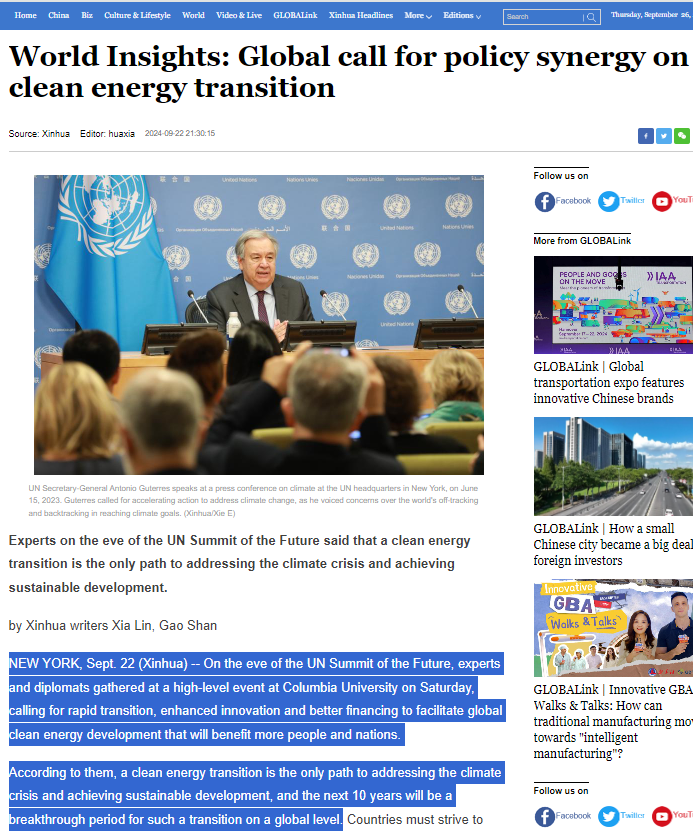
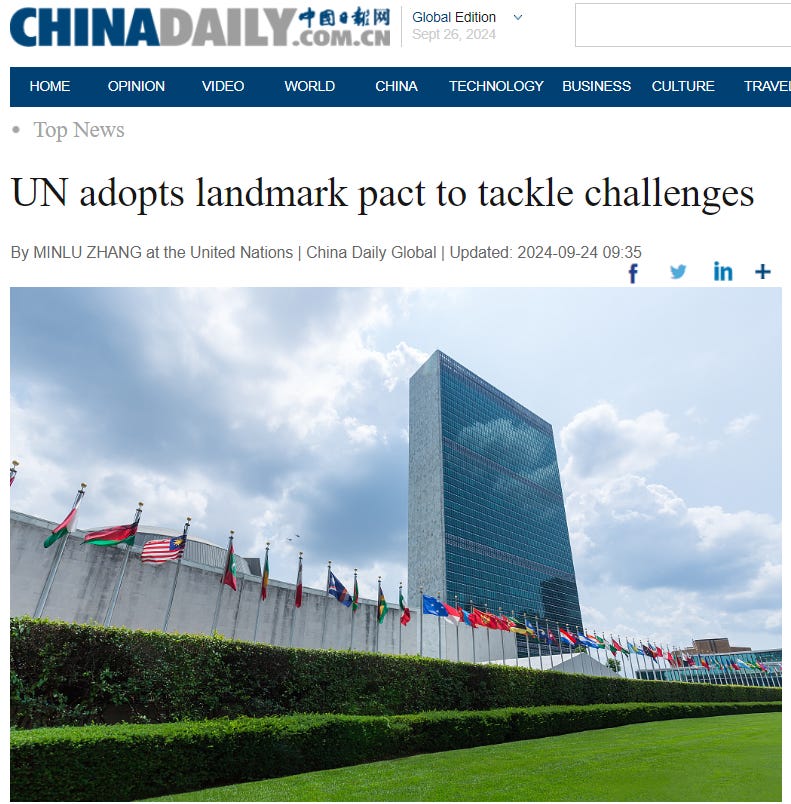

Hey, hey, am I detecting traces of sarcasm in this text?! This is no way to talk about your scaley benefactors! Take a look at the fine China Daily for hints on how to give your hidden government proper praise and support.
Consensus
That's the emperor's butt right there.
It just takes one brave enough to call it.
Asch conformity experiment anyone?
“countries are not riding separately in some 190 small boats, but rather we're all in a giant ship on which our shared destiny hinges”:
That's putting all our eggs in one basket.
Or sinking ship.
Looks as though our grandparents' wisdom should be brought back for our grandchildren's future rather than this bunch of deranged lunatics.